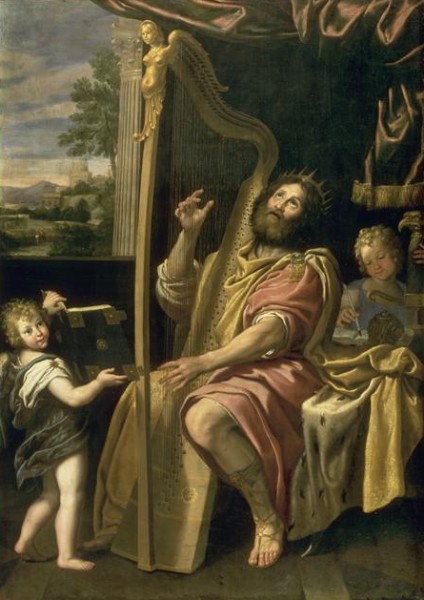
Zampieri, King David Playing the Harp
Lecture 7. November 18, 1947
For farming people the sacrifice was concerned with the cycle of crops. First it was the pastoral, hunting age of existence, the Stone Age. It was followed by farming, the new Stone Age. To tell this story, the Bible gives us Cain and Abel, the pastoralist and the farmer. The Bible deals symbolically with what we have dealt with historically. From the tillers of the soil come the village, the city—the move from stone to bronze to iron.
Out of the unity of social interests comes the unity of religion. Judaism and Christianity evolve out of a Mediterranean culture and religion. Palestine would be less independent than any other country because it is at the crossroads of the world. To expect a unique experience in Palestine would be like expecting New York to be invaded by wild Indians.
Much of the pre-prophetic religion is obliterated because the Old Testament is founded on prophetic writings. Solomon’s temple shows a generous mixing up of religious influences. His successors show that every king who Does Right keeps to Jehovah and every king who Does Wrong mixes cults, which include Moloch. There are hints of pre-prophetic religion in the story of Jephthah’s daughter, and at the end of Judges are queer stories of an abominated religion.
Samuel Book II, Chap. 21, describes an oracle system. When the famine comes one consults the oracle. David inquires because he is the king and therefore responsible for the famine as the principle of fertility in the society. It is a private prayer, but really an oracle. There is a feeling of divine vengeance for some crime, as in Greek tragedy. Because crime is unnatural, nature must right herself. It is the act of treachery of Saul that causes the sin that caused the famine. However, Jonathon’s son is spared.
Ideas persist of a human sacrifice at harvest to right the famine. The sacrifice originally is the tribe in communion as one man––through the one man who symbolizes the unity of the tribe. They enter into communion as one body. For the farmer, the blood becomes the vintage and the flesh the harvest. The man sacrificed becomes the regular recurrence of the cycle of nature as well as the unity of the tribe. There is no symbolism here; they are the body and the blood.
IDEAS OF KINGSHIP
The Israelite kings take on the symbolic attributes. The Israelites do not have kings for a long time; there is a distrust of state religion. The choosing of Saul is told twice in Samuel I, from the side of supporters and from the opposition side. The Israelites are aware of the lurking danger in the conception of a divine man, of the idolatry which is associated with the king. Saul is the biggest man in Israel. He is a great tragic figure, like Achilles sulking in his tent.
David is the symbol of what a king is. The Judaic phase of the Pharisees and Maccabean rebellion is the time when the Psalms were gathered. The Psalms concentrate on the king, like King Arthur. Solomon is the king of a united nation. He and David are the Great Kings. They represent a man of peace and a man of war, the wise and the valiant kingship. There is a primitive idea in kingship that the king must humble himself and that any wrong to society must be his fault. David must humble himself; the wrong is his fault. In the Psalms, the cult of the king is so symbolic that the historical David has little to do with it. Psalms 2 and 110 show the cult of the divine king.
There are two interpretations of kingship and therefore there must be a showdown between the spiritual and the physical king. In a monarchy, the literary king takes on qualities of a divine king, which will be interpreted in historical terms, e.g., the king will have the power to beat the Babylonians, etc. The issue must be forced between the divine and the physical king. As long as you have the King, the Temple, and a symbolic God, you will have a King to whom all of these qualities are attached.
The showdown comes when a foreign enemy triumphs. (In the Aeneid, the defeat of the people means the defeat of the god that protects those people.) To get past the idea of your God to the only possible God, the chosen Son and the Chosen People, you have to take a big step.
The Book of Lamentations is an elegiac poem on the fall of Jerusalem at the hands of Nebuchadnezzar. Chap. 19: the king is captured; he is their God and he’s done for and so are they. From Jeremiah on, the issue is forced more and more between symbol and the realization that the king must be a universal spiritual force.
Trying to rebuild the Temple and the Monarchy in physical form is Judaism. That was the atmosphere when Jesus began his work. People were hanging on to the visible symbol and did not know what Jesus meant. All their hopes were bound up with the Temple. Jesus said, I will restore it in three days, meaning the temple of his body. He is the man whose body is the whole people. The real temple, therefore, is the body of God’s people. The people are in the form of one man’s body.
This is the Old Testament idea of the doctrine of the divine man, the Son of God who is all his people in bodily form. He is responsible for the calamities of the people. The king takes upon himself the miseries of the people. The idea of suffering is attached to the idea of the king; he is also put to death when his powers fail.
